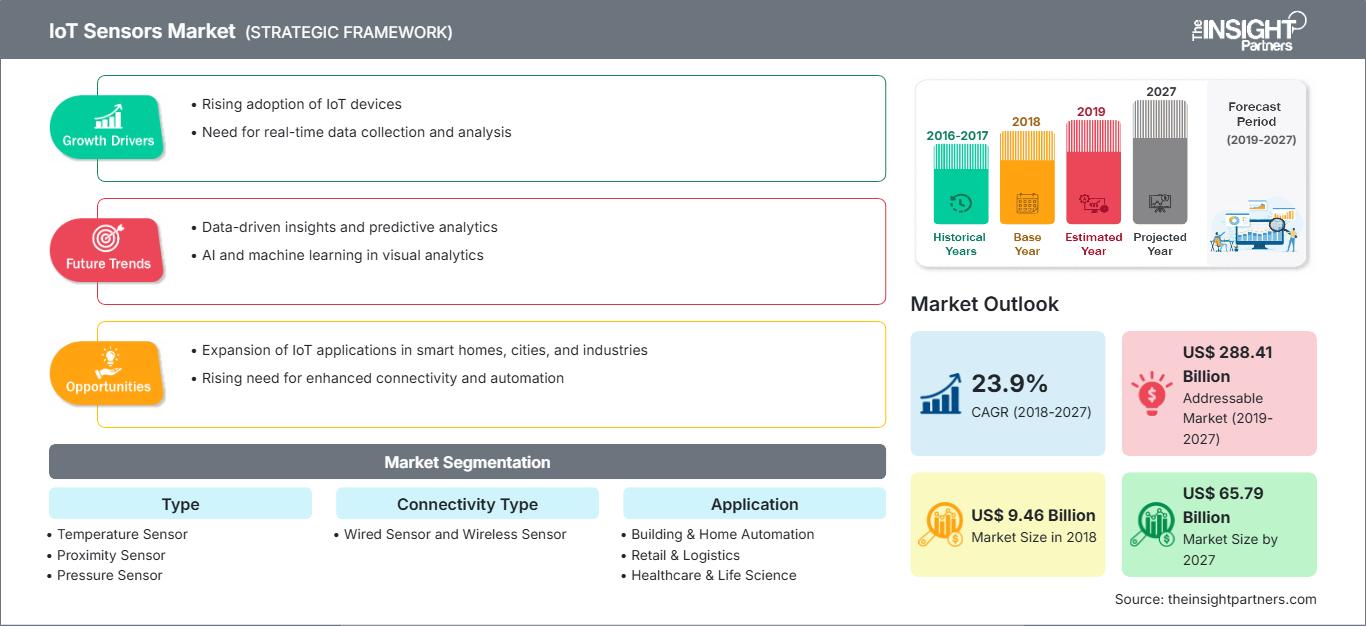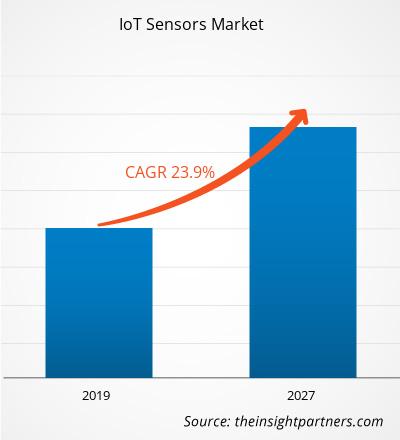2018 年,物联网传感器市场规模为 94.6 亿美元,预计在 2019 年至 2027 年预测期内,复合年增长率将达到 23.9%,到 2027 年将达到 657.9 亿美元。
2018 年,北美是领先的物联网传感器市场,预计亚太地区将在整个预测期内实现最快增长。在北美,技术的进步导致了激烈的市场竞争。北美是技术发展的中心,由经济强劲的国家组成。这些公司正在不断改进整体业务流程,以便以最佳方式满足客户对高质量产品和服务的需求。作为一个技术先进的国家,加上居民可支配收入高,消费电子行业在该地区蓬勃发展。该地区消费电子设备的密度相当高。这些因素推动了北美物联网传感器市场的发展。物联网传感器市场洞察
消费电子行业的崛起
消费电子行业正在经历巨大的增长。在当前形势下,全球消费者使用各种消费电子设备来完成各种各样的任务。智能手机、平板电脑、个人电脑、音乐播放器等消费电子设备已成为消费者生活中不可或缺的一部分。随着技术的不断进步,消费设备也变得越来越智能。人工智能应用刺激了对更廉价传感器的需求。由于多家半导体公司不断推出吸引该行业的先进技术,消费电子市场在当前形势下正在增长。此外,可穿戴设备是物联网连接设备行业增长最快的领域之一。先进的企业认为可穿戴设备是移动技术的绝佳机遇,可以提高效率、改进工作流程并增强沟通。
自定义此报告以满足您的要求
您将免费获得任何报告的定制,包括本报告的部分内容,或国家级分析、Excel 数据包,以及为初创企业和大学提供超值优惠和折扣
物联网传感器市场: 战略洞察

-
获取本报告的主要市场趋势。这个免费样本将包括数据分析,从市场趋势到估计和预测。
联网汽车使驾驶员或汽车本身能够自动共享车内和车外的数据。物联网 (IoT) 正是这些突破性技术之一,它为汽车制造商提供了一系列全新的产品和服务,为传统的汽车认知打开了全新的层面。这些新配置可能包括传感器、控制器、照明和软件应用程序,这些产品和服务以独立的形式提供,客户可以根据需求即插即用,或者将某些功能内置于新一代汽车中。这些系统可以部署在车辆的信息娱乐系统或自动控制单元中。联网汽车和自动驾驶汽车研究的推进将进一步扩大物联网传感器在车辆中的集成范围。
类型洞察
物联网传感器市场根据类型细分为温度传感器、光传感器、压力传感器、化学传感器、运动传感器等。物联网需要各种类型的传感器来提高应用程序的性能可靠性。除非所有设备或系统都配备传感器,否则物体无法捕捉状态或执行操作。
连接类型洞察
按连接类型划分,物联网传感器市场进一步细分为有线和无线。两种连接各有优缺点,彼此区别开来。有线连接更可靠、更安全,并且不易受到地板、墙壁、机柜或任何电子设备干扰等局部因素的影响。而由于物联网传感器市场中存在大量制造商,无线连接是一种高度可扩展且经济高效的技术。
另一方面,有线连接缺乏移动性和更好的可扩展性。由于人工和线路安装成本较高,这些连接价格昂贵。此外,由于信号干扰,无线连接速度相对较慢,并且容易受到电子设备干扰。因此,合适的解决方案因业务用例而异。物联网技术的安装方法多种多样,因此取决于设备的位置和情况。影响网络类型选择的因素包括功耗、网络范围、互操作性、网络带宽、间歇性连接和安全性。
市场主动性被视为全球物联网传感器市场采用最多的策略。近期为部署新技术解决方案而建立的一些合作伙伴关系和合同联盟如下:
2019 年:欧姆龙公司在全球共推出了 2,512 种直流三线 E2E NEXT 系列接近传感器,该系列传感器拥有世界上最长的感应距离 (*1),现全新配备物联网功能。这些传感器将设施突然停机的风险降低了 3 倍 (*2);它们还能检测到警告此类停机的信号并通过网络通知用户。
2018 年:Arm Holdings 推出针对自动驾驶汽车传感器的芯片。 Arm 最新的芯片设计名为 Cortex-A65AE,其设计理念是能够近乎实时地处理来自自动驾驶汽车传感器的数据流。这款芯片不仅具备新的安全功能,还具备快速处理和传输传感器数据的功能。它还能够快速连接到 Nvidia 等公司的图形处理器。这些图形处理器正被汽车制造商采用,而 Arm 的芯片将作为这些处理器的补充。
2017 年:恩智浦 (NXP) 推出了新的 NFC 芯片和传感器,以保障物联网安全。恩智浦推出了两款用于温度监控和冷链物流的 NTAG 智能传感器,以及一款兼容 Arduino 的 NTAG I²C Plus 套件,允许开发人员在嵌入式电子系统中使用 NTAG I²C Plus 连接的标签芯片进行模拟。
物联网传感器市场区域洞察
The Insight Partners 的分析师已详尽阐述了预测期内影响物联网传感器市场的区域趋势和因素。本节还讨论了北美、欧洲、亚太地区、中东和非洲以及南美和中美洲的物联网传感器市场细分和地域分布。
物联网传感器市场报告范围
| 报告属性 | 细节 |
|---|---|
| 市场规模 2018 | US$ 9.46 Billion |
| 市场规模 2027 | US$ 65.79 Billion |
| 全球复合年增长率 (2018 - 2027) | 23.9% |
| 历史数据 | 2016-2017 |
| 预测期 | 2019-2027 |
| 涵盖的领域 |
By 类型
|
| 覆盖地区和国家 |
北美
|
| 市场领导者和主要公司简介 |
|
物联网传感器市场参与者密度:了解其对业务动态的影响
物联网传感器市场正在快速增长,这得益于终端用户需求的不断增长,而这些需求的驱动因素包括消费者偏好的不断变化、技术进步以及对产品优势的认知度不断提高。随着需求的增长,企业正在扩展其产品线,不断创新以满足消费者需求,并抓住新兴趋势,从而进一步推动市场增长。

- 获取 物联网传感器市场 主要参与者概述
全球物联网传感器市场细分
按类型
- 温度传感器
- 光传感器
- 压力传感器
- 化学传感器
- 运动传感器
- 其他
按连接类型
- 有线
- 无线
按应用
- 消费电子
- 楼宇自动化
- 医疗保健
- 汽车
- 工业
- 零售
- 其他
按地域
-
北美美洲
- 美国
- 加拿大
- 墨西哥
-
欧洲
- 法国
- 德国
- 英国
- 俄罗斯
- 欧洲其他地区
-
亚太地区 (APAC)
- 韩国
- 澳大利亚
- 中国
- 印度
- 日本
- 亚太地区其他地区
-
中东和非洲 (MEA)
- 沙特阿拉伯
- 南非
- 阿联酋
- MEA 其他地区
-
南美洲 (SAM)
- 巴西
- 阿根廷
- SAM 其他地区
公司简介
- Analog Devices, Inc.
- ARM Holdings PLC
- Broadcom, Inc.
- Honeywell International, Inc.
- Infineon Technologies AG
- NXP Semiconductors NV
- Omron Corporation
- Robert Bosch Gmbh
- STMicroelectronics NV
- Texas Instruments Incorporated
- 历史分析(2 年)、基准年、预测(7 年)及复合年增长率
- PEST和SWOT分析
- 市场规模、价值/数量 - 全球、区域、国家
- 行业和竞争格局
- Excel 数据集
近期报告
相关报告
客户评价
购买理由
- 明智的决策
- 了解市场动态
- 竞争分析
- 客户洞察
- 市场预测
- 风险规避
- 战略规划
- 投资论证
- 识别新兴市场
- 优化营销策略
- 提升运营效率
- 顺应监管趋势






















 获取免费样品 - 物联网传感器市场
获取免费样品 - 物联网传感器市场